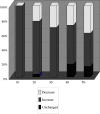Cross-sectional area of posterior extensor muscles of the cervical spine in asymptomatic subjects: a 10-year longitudinal magnetic resonance imaging study
- PMID: 21431426
- PMCID: PMC3175907
- DOI: 10.1007/s00586-011-1774-x
Cross-sectional area of posterior extensor muscles of the cervical spine in asymptomatic subjects: a 10-year longitudinal magnetic resonance imaging study
Abstract
There has been no prospective study on age-related changes of the extensor muscles of the cervical spine in healthy subjects. This study was conducted to elucidate any association between the changes in cross-sectional area of the extensor muscles of the cervical spine on MRIs and cervical disc degeneration or the development of clinical symptoms. Sixty-two subjects who underwent MR imaging by a 1.5-Tesla machine between 1993 and 1996 as asymptomatic volunteers in a previous study were recruited again 10 years later for this follow-up study. The mean interval between the studies was 11.0 ± 0.7 years. The cross-sectional areas of the multifidus, semispinalis cervicis, semispinalis capitis, and splenius capitis at C3-C4, C4-C5, and C5-C6 intervertebral levels were measured on T2-weighted axial images using Image J 1.42. The mean cross-sectional areas of the deep extensor muscles were 1,396.8 ± 337.6 mm(2) at the C3-C4 level, 1,514.7 ± 381.0 mm(2) at the C4-C5 level, and 1,542.8 ± 373.5 mm(2) at the C5-C6 level in the previous investigation. The cross-sectional areas were 1,498.7 ± 374.4 mm(2) at the C3-C4 level, 1,569.9 ± 390.9 mm(2) at the C4-C5 level, and 1,599.6 ± 364.3 mm(2) at the 10-year follow-up. An increase in the cross-sectional area of the muscles was more frequently observed in subjects in their tens to thirties in the initial study, while a decrease was more frequently observed in those in their forties and older in the initial study. Disc degeneration was not correlated with a change in extensor muscle volume. Development of shoulder stiffness during follow-up was significantly negatively correlated with a change in the cross-sectional area of the deep extensor muscles.
Figures



References
-
- Booth FW, Weeden SH, Tseng BS. Effect of aging on human skeletal muscle and motor function. Med Sci Sports Exerc. 1994;26:556–560. - PubMed
-
- Cohn SH, Vartsky D, Yasumura S, et al. Compartmental body composition based on total-body nitrogen, potassium, and calcium. Am J Physiol. 1980;239:524–530. - PubMed
Publication types
MeSH terms
LinkOut - more resources
Full Text Sources
Medical
Miscellaneous

